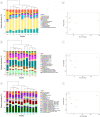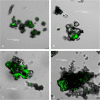Microbial Community Characterizing Vermiculations from Karst Caves and Its Role in Their Formation
- PMID: 33156395
- PMCID: PMC8062384
- DOI: 10.1007/s00248-020-01623-5
Microbial Community Characterizing Vermiculations from Karst Caves and Its Role in Their Formation
Abstract
The microbiota associated with vermiculations from karst caves is largely unknown. Vermiculations are enigmatic deposits forming worm-like patterns on cave walls all over the world. They represent a precious focus for geomicrobiological studies aimed at exploring both the microbial life of these ecosystems and the vermiculation genesis. This study comprises the first approach on the microbial communities thriving in Pertosa-Auletta Cave (southern Italy) vermiculations by next-generation sequencing. The most abundant phylum in vermiculations was Proteobacteria, followed by Acidobacteria > Actinobacteria > Nitrospirae > Firmicutes > Planctomycetes > Chloroflexi > Gemmatimonadetes > Bacteroidetes > Latescibacteria. Numerous less-represented taxonomic groups (< 1%), as well as unclassified ones, were also detected. From an ecological point of view, all the groups co-participate in the biogeochemical cycles in these underground environments, mediating oxidation-reduction reactions, promoting host rock dissolution and secondary mineral precipitation, and enriching the matrix in organic matter. Confocal laser scanning microscopy and field emission scanning electron microscopy brought evidence of a strong interaction between the biotic community and the abiotic matrix, supporting the role of microbial communities in the formation process of vermiculations.
Keywords: Cave ecology; Geomicrobiology; Next-generation sequencing; Pertosa-Auletta Cave; Underground ecosystem; Vermicular deposits.
Conflict of interest statement
The authors declare that they have no conflict of interest.
Figures




References
-
- Lee NM, Meisinger DB, Aubrecht R, Kovacik L, Saiz-Jimenez C, Baskar S, Baskar R, Liebl W, Porter ML, Engel AS. Caves and karst environments. In: Bell EM, editor. Life at extremes: environments, organisms and strategies for survival. Wallingford: CABI; 2012. pp. 320–344.
-
- Tomczyk-Żak K, Zielenkiewicz U. Microbial diversity in caves. Geomicrobiol J. 2016;33:20–38. doi: 10.1080/01490451.2014.1003341. - DOI
-
- Kováč Ľ. Caves as oligotrophic ecosystems. In: Moldovan OT, Kováč Ľ, Halse S, editors. Cave Ecology. Cham: Springer International Publishing; 2018. pp. 297–307.
-
- Northup DE, Lavoie KH. Geomicrobiology of caves: a review. Geomicrobiol J. 2001;18:199–222. doi: 10.1080/01490450152467750. - DOI
-
- Galdenzi S, Maruoka T. Gypsum deposits in the Frasassi caves, central Italy. J Cave Karst Stud. 2003;65(2):111–125.
MeSH terms
Grants and funding
LinkOut - more resources
Full Text Sources

